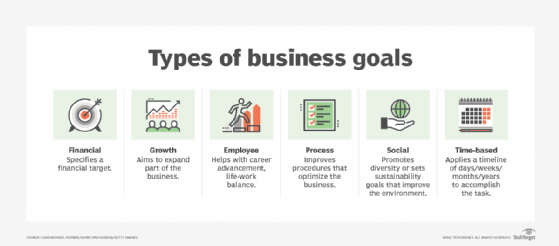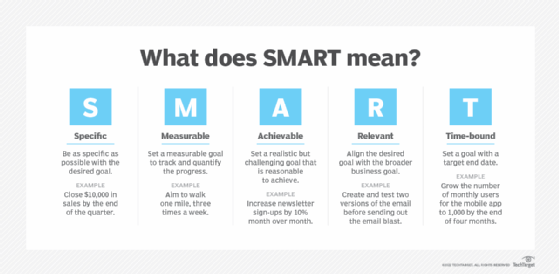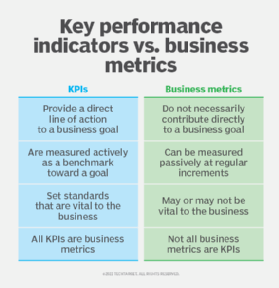What is an organizational goal?
Organizational goals are strategic objectives that a company's management establishes to outline expected outcomes and guide employees' efforts toward the achievement of those outcomes.
There are many advantages to establishing organizational goals. They guide employee efforts, justify a company's activities and existence, define performance standards, provide constraints for pursuing unnecessary goals, and function as behavioral incentives.
For the goals to have business merit, organizations must craft a "big picture" strategic plan for choosing and meeting them.

Why are organizational goals important?
Establishing organizational goals serves to clarify what objectives should be pursued and why. Clear goals also give valuable direction to employees, set benchmarks for performance, build workplace harmony, and encourage employees to help the firm in its pursuit. Setting goals can also encompass aligning individual employee goals to the overall goals and measuring individual performance accordingly.
Properly planned goals can help a business grow and strengthen its competitive posture. A consistent, well-tuned goal-setting process can help improve a firm's efficiency, productivity and profitability. Clear, measurable goals grounded in strong reasoning and logic also tend to preclude unnecessary or potentially harmful goals.
Goals are foundational to a company's short-, medium- and long-term financial objectives. Organizations that set specific goals can also more readily achieve compliance as well as measure their progress (applying business analytics), identify bottlenecks, and determine the potential for improvement in the most critical areas.
SMART organizational goals
To be effective, organizational goals must be SMART:
- Specific.
- Measurable.
- Achievable.
- Relevant.
- Time-bound.
By setting comprehensive, realistic and SMART goals, organizations have a clearer path to achieve success and realize their vision.

Of course, setting SMART goals must be accompanied by goal communication and execution. After ensuring that their goals satisfy the SMART criteria, organizations should communicate the goals to employees. While this communication can happen through formal or one-to-many channels like company newsletters or emails, the most impactful way to communicate goals to employees is through their direct supervisors. As part of this approach, line managers can work with their staff to develop SMART individual or team goals that align with the organization's larger or broader goals.
Regardless of the communication method used, clear, unambiguous information can help to better engage employees, increase their motivation and help them determine the optimal course of action. Employees should also have the proper tools and resources to support their work in pursuit of stated organizational goals.
It's also important to review the utility and feasibility of organizational and individual goals regularly. Some goals might turn out to be unrealistic and impossible to achieve. Others might lose their relevance or measurability. In these cases, the goals should be modified based on the latest available information and the most recent company objectives.

Types of organizational goals
There are three main types of organizational goals:
1. Strategic goals
These are the big picture, qualitative, long-term goals an organization aims to achieve. Strategic goals detail a company's objectives as described in its mission statement or in other public statements, such as a corporate charter or annual reports. They help to build the organization's public image and reputation; they can be qualitative and hard to measure using quantitative metrics.
2. Tactical goals
These are more granular, qualitative goals that focus on transforming big picture goals into operational goals. Tactical goals are often team goals. They typically include a quantitative element and bridge the gap between strategic and operative goals. They help connect measurable everyday business processes to the goals outlined in a company's strategic plan.
3. Operative goals
Operative goals are often short-term goals organizations seek to achieve through their operating policies and undertakings and are measured quantitatively. Their success is based on metrics. Companies can outline the specific steps they need to take to achieve operative goals.
Operative goals, which might be smaller team goals or individual goals, are the actual, concrete steps an organization intends to take to achieve its purpose. These include specific, day-to-day operational tasks needed to run a business and help drive scalability and business growth. Key organizational goals can also include employee and management performance, productivity, profitability, innovation, market share and social responsibility goals.
A business's operative goals might not parallel its official goals. For example, a nonprofit organization's main official goal might be community service. However, funding limitations might mean that another operative goal -- fundraising -- takes precedence for a time or is seen as equally important.
The overlaps between strategic, operational and tactical goals
A company's strategic, tactical and operational goals might have some overlap. This might occur because achieving one type is necessary to fulfill another.
For example, if a company's official strategic goal is to increase customer satisfaction by offering multichannel or omnichannel customer support through social media, mobile, live chat and email, its tactical goals might be to first integrate all these channels and to capture all business process requests in a unified, centralized tool. Smaller operative goals can be used to enable the integration, and to assign business processes and individuals to the effort.
The strategic goal will be achieved upon meeting the operational and tactical goals.
Steps for setting organizational goals
Setting up organizational goals usually involves the following steps:
- Assess the state of the business. Examine the current state of the business and external factors that affect it, such as industry trends or regulatory changes. A SWOT analysis will reveal strengths, weaknesses, opportunities and threats, which can provide useful inputs for goal-setting.
- PESTLE. A PESTLE (political, economic, social, technological, legal, environmental factors) analysis can also be useful for accounting for external factors. Identifying strengths and weaknesses in these areas is particularly useful for setting operational goals.
- Establish and clarify each goal. Decide how the business or team wants to use this information to improve itself. Brainstorm goals and select those that could best capitalize on growth opportunities.
- Prioritize goals. Establish an implementation time frame and delegate goals to different teams or team members based on role, responsibility and goal priorities. Consider both internal and external factors when determining deadlines and milestones.
- Establish measurement metrics. Determine how progress will be measured. Some goals might more readily lend themselves to quantitative measurement. Set tangible benchmarks that, while a worthy stretch, are feasible for teams to reach.
- Integrate goals with processes. Incorporate the goals into the team's or business's way of working and develop methods to achieve them in the predetermined time frame.
- Communicate goals with key stakeholders. Share the goals in a clear, concise way with key stakeholders who will be involved in the pursuit. Explore ways that different teams can work together to reach the goals.
- Evaluate progress. As progress is made or circumstances change, evaluate progress using predefined metrics. Revise goals and optimize processes, if appropriate. Encourage feedback to assess goals and team performance.
Examples of organizational goals
Every organization will have different goals, depending on its current situation and outlook. Some examples of goals might include the following:

- Reduce the time it takes to process online orders.
- Keep software up to date by applying security patches weekly or monthly.
- Improve customer service interactions by improving call center productivity by 20% or reducing average handle time by 15%.
- Become carbon-neutral by Year X.
- Cut employee attribution by 10% by Year Y.
- Incorporate 5G architecture into the business's infrastructure by Year Z.
- Increase profitability by 25% within the next two quarters.
For all these goals, the company would first assess the state of the business, establish the goals with key performance indicators, organize and prioritize the goals, integrate each goal into existing workflows and processes, and measure progress based on the established metrics.
Learn how business can plan for and build a 5G deployment, and the benefits of doing so. Also, setting detailed business goals with deadlines motivates employees and keeps your company on track. Learn how to set business goals in this step-by-step guide.







